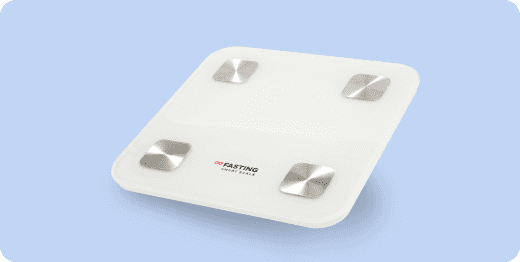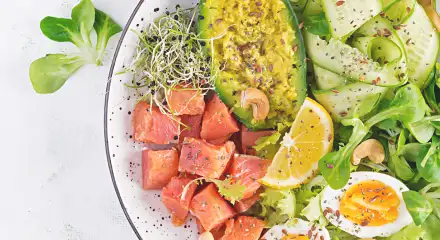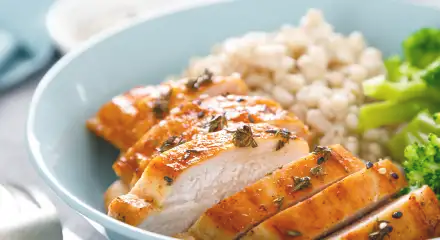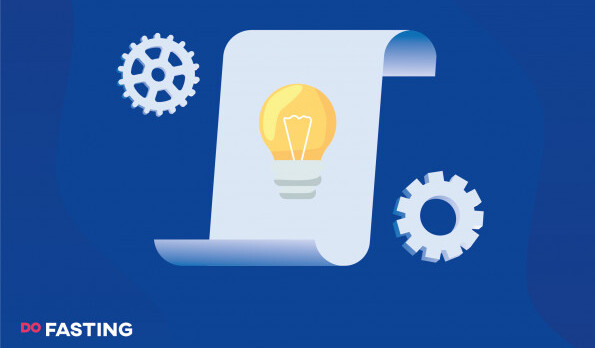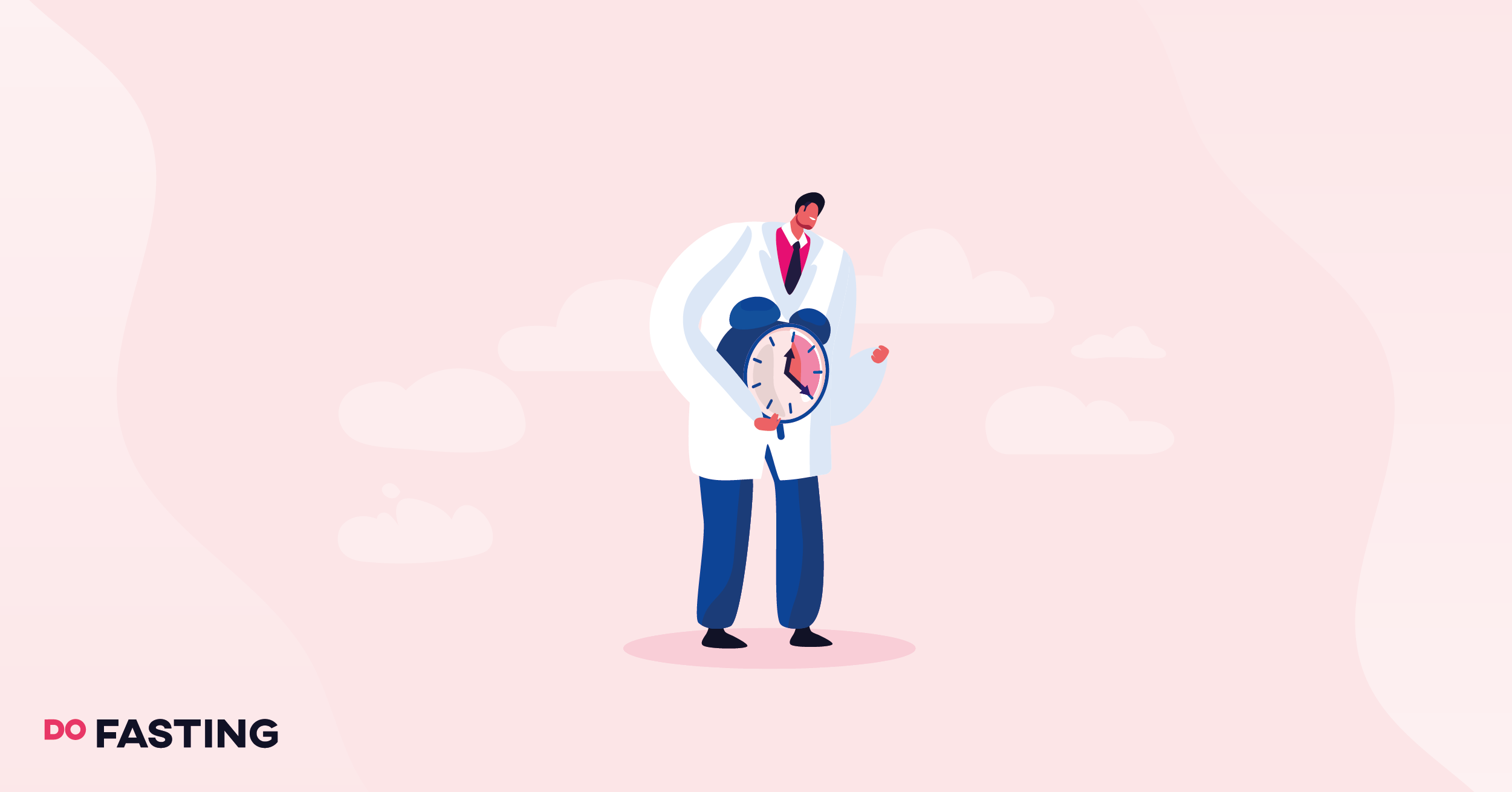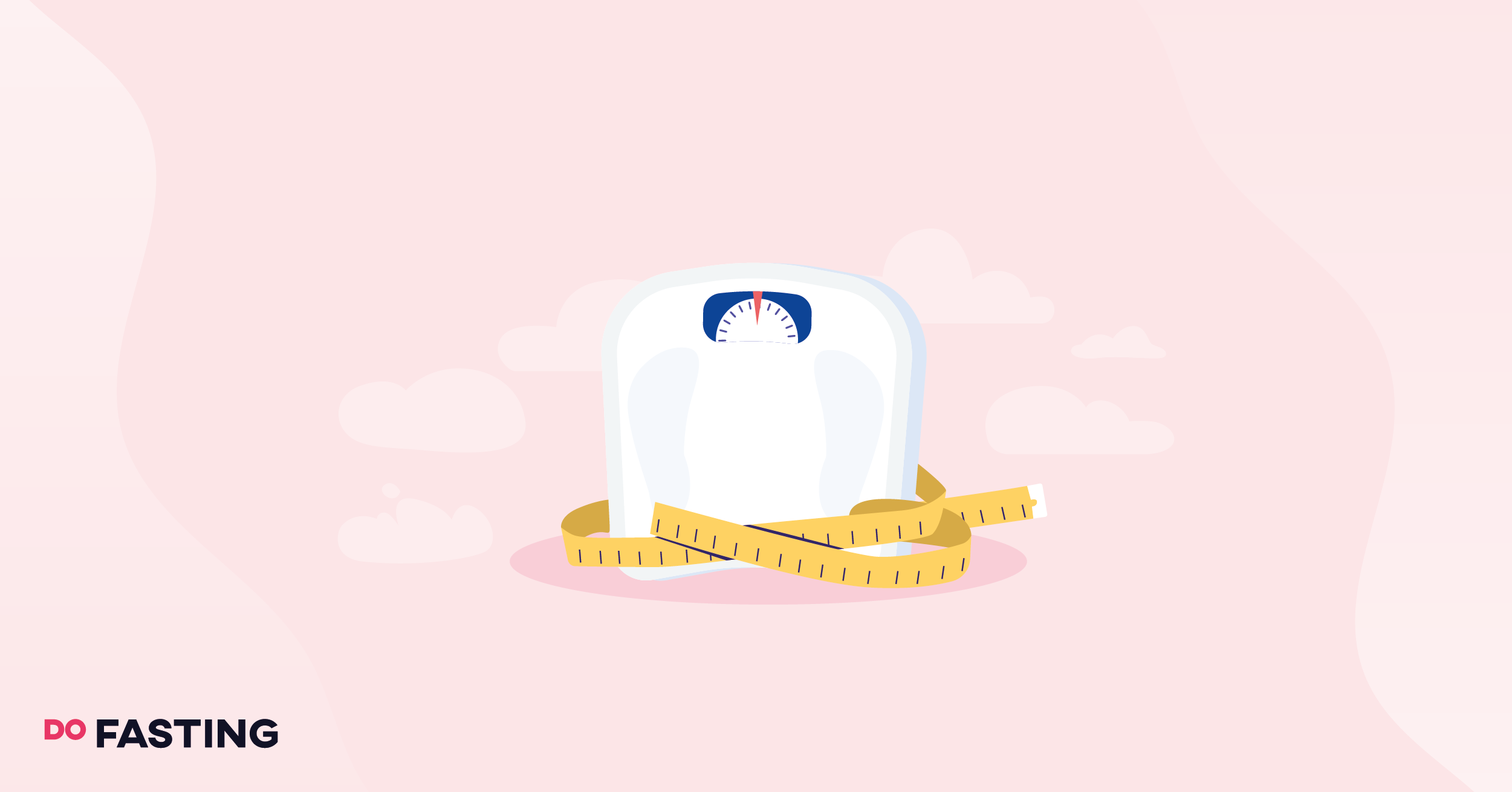Contents
What Is the Keto Diet?
The ketogenic diet is a low-carb, high-fat diet that lowers glucose and insulin levels. The drop in blood glucose shifts your metabolism toward burning ketones and fat. You can eat foods with low carbohydrates and incorporate healthy fats into your daily meals.
Many people stick to eating foods like salmon, avocados, berries, nuts, chicken, eggs, almond milk, cheese, and green leafy vegetables. There are plenty more products to choose from, but these specifically contain high levels of protein, fiber, and vitamins.
Take a
1-minute quiz
and discover how much weight you can lose with DoFasting!
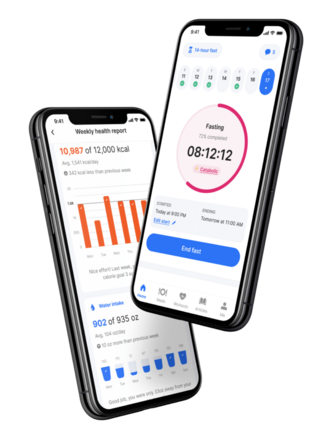
What Is Ketosis, and How Does It Work?
Ketosis is the process that occurs when your body doesn’t have enough carbohydrates to burn for energy. Instead, the body burns fat and produces ketones to keep you energized. This metabolic process should lower your body fat percentage.
How Long Does It Take to Lose Weight With Keto?
Weight loss is different for everyone and can depend on factors like your body fat percentage, gender, height, physical exercise, and diet plan.
Let’s take a look at the four stages of weight loss during the ketogenic diet:
Safe Pace to Lose Weight
It’s critical not to overexert yourself when losing weight. Physical changes take time and may vary from person to person. You should always follow a sustainable weight loss plan that contains keto-based meals and at least 30 minutes of exercise a day.
The recommended weight loss per week is 1-3 pounds or about 0.5-1kg. Exceeding this could mean you’re not eating enough. However, weight loss might be faster initially due to a drop in water weight, so you can expect to lose around 3-4 pounds in the first week.
Stepping on the dreaded scales can be challenging, but there are other ways to track your weight loss progress. You can use a measuring tape to measure certain parts of your body, or you can try on old clothes to see how they fit.
Phase 1: Lose Water Weight After 1 Week
You’re bound to lose water weight on a low-carb diet. This usually happens in the first 1-2 weeks of changing your eating habits. Most of those lost pounds will only be water weight, since you can’t physically burn over 2 pounds of fat in a short amount of time.
After losing a percentage of water, your body will use up spare carbs and produce ketones for energy. You won’t be burning fat during this stage, but you’ll still lose abnormal cells and unnecessary carbs that trigger bloating.
The first initial week can trigger the keto flu – a bout of symptoms ranging from headaches, foggy brain, constipation, nausea, mood swings, and irritability. Keto flu should only last around a few days after starting the ketogenic diet.
Phase 2: Start Burning Fat in 1 Month
Now you’ve hit the one month mark and you’re starting to lose fat. Your body has reached ketosis, and no longer needs carbs for energy. In just 2-4 weeks, you’ll notice small changes in your body, like a reduced belly pouch or more defined legs.
After two weeks, the keto flu symptoms should be gone. You might experience hunger spikes now and then, but you’ll eventually grow accustomed to the new diet. Tiredness and mood swings are perfectly normal when going through a lifestyle change.
You might burn 1-2 pounds of fat each week, depending on exercise and calorie intake. This is a good amount to lose when eating minimal carbs and exercising.
Phase 3: Become Fat Adapted After 90 Days
Reaching the end of the 2-3 month mark, your body will be fully fat adapted. Most of the lost weight comes from your metabolism burning fat on stubborn limbs. Those hunger cravings may also disappear once you feel comfortable eating a low-carbohydrate diet.
You’ll continue to lose around 1-2 pounds per week, but this progress might slow down. Fat loss is always faster during the first few months of your dietary plan. This is due to your body eliminating unnecessary water weight that makes those scales go up.
Phase 4: Maintain Your Weight With Keto
Reaching your goal weight can be a huge milestone, but you need to follow the right steps to maintain it. Carb cycling is one way to maintain your current weight without putting fat back on. This involves having high-carb and low-carb food days.
You would usually plan a high-carb day when performing strenuous exercise. This might be high-intensity interval training (“HIIT”) or weight lifting.
Low-carb meals are for less active days. This gives your body the chance to burn more fat and not just carbohydrates, meaning weight gain isn’t likely to happen. Carb cycling is just one way to enhance muscle gain and performance at the gym.
How Does the Keto Diet Promote Weight Loss?
There are many ways the ketogenic diet can increase weight loss. It will reduce the fat on your body that might be challenging to lose through just physical activity.
Here are four ways the keto diet can burn stored fat:
Reduces Appetite
Limiting your carb intake decreases appetite-stimulating hormones such as insulin and ghrelin. This can prevent binge eating or unhealthy snacking throughout the day. Eating the right amount of calories is great for losing weight on the keto diet.
Improved Insulin Sensitivity
The ketogenic diet can improve your insulin sensitivity – enhancing fuel utilization and metabolism. This will prevent high blood sugar levels, as your body is more adaptable to using glucose more effectively. Your sugar levels should stay between 70 and 99mg/dL.
Decreased Fat Storage
Eating fewer carbs reduces the rate of fat storage. Your body won’t turn all the sugar into fat and store it in stubborn areas like your stomach, arms, and thighs. The ketogenic diet can prevent future weight gain due to this sugar reduction process.
Increased Fat Burning
There’s no doubt that a diet containing low net carbs can enhance fat burning. Your body is already in the state of ketosis – a stage that focuses on using fat for energy. More physical activity will only speed up your weight loss progress.
4 Factors That Influence Weight Loss
Physical and genetic factors can influence how much weight you lose on your fitness journey. Everyone is bound to have a unique experience on ketogenic diets.
Here are four factors that may influence weight loss:
-
Gender and Age
Men and women can lose weight at different points in their diet. This is due to men having more lean muscle tissue that burns more calories than fat. Women are supposed to have more fat storage for pregnancy, so it might be harder to burn over time.
Age is another factor that determines how much weight disappears. Getting older means your metabolism is slowing down. This may disrupt your progress if foods don’t get broken down properly. Muscle loss also contributes to the slow metabolic rate.
-
Initial Weight
Your starting weight can affect long-term weight loss results. People who weigh more typically lose fat quickly during the first few weeks. This is due to how much energy their body needs to function, either through breathing, walking, and resting.
-
Calorie Deficit
Consuming less calories than your maintenance level can encourage your body to burn more fat. You need to cut at least 400-500 calories out of your current diet. It might help to track your calories throughout the day to make sure you’re not eating too much.
-
Sleep
Getting enough sleep is vital for achieving weight loss. Chronic lack of sleep can lead to metabolic dysregulation. This occurs when chemical reactions in your body disrupt the metabolic process. You might have too much glucose that adds to your fat storage.
8 Ways to Accelerate Keto Weight Loss
A low-carb, high-fat diet might not be enough to lose weight. You should try other popular weight loss methods when restricting your daily net carbs.
Let’s take a look at 8 ways you can accelerate weight loss:
-
Try Intermittent Fasting
Intermittent fasting is a weight loss method that restricts your eating times. It’s not a diet, but more of a schedule that comprises no eating during certain periods. Through time-restricted windows, your body learns to lose fat and regulate glucose levels.
You can try this method on the ketogenic diet. Eating low-carb foods at strict intervals may ensure your body burns fat quickly. Hitting those weight loss stalls can be challenging, but simply changing your eating times can speed up the progress again.
The 12/12 fasting option is a good place to start for beginners. You need to fast for 12 hours and eat during the last half. So, you might have the fasting window from 8 pm to 8 am the next day. The fasting length is something you can extend over a few weeks.
Fasting is a challenging lifestyle change, but there is a guide to move you through the process. DoFasting is an app that gives you a customized daily fasting schedule of your dietary needs. Tracking fasts is a better way to monitor your weight loss progress!
Take a
1-minute quiz
and discover how much weight you can lose with DoFasting!

-
Start Exercising
Exercise is the best way to burn more calories and boost your metabolism. You should do at least 300 minutes of exercise per week to lose weight.
Physical activity also helps you reach ketosis faster. This is due to your body using up spare glucose storage. No available sugar alcohols means the metabolism needs fat for energy instead, encouraging a ketosis state that decreases your fat mass.
Some good exercises are running, cycling, and HIIT. These get your heart pumping and encourage the body to burn extra calories throughout the day. A proper keto lifestyle should involve exercises that cause significant weight loss.
-
Start Tracking Your Calories
Tracking calories prevents you from overeating on the keto diet. You can limit your meal portions, reduce snacks, keep a food diary, or use an app to monitor calorie intake. Eating fewer calories than your body needs ensures it uses excess fat for energy.
-
Minimize Your Carb Intake
A keto diet requires you to reduce your carbs to 20 grams per day. This will ensure you maintain ketosis. Consider tracking your macros, eating unprocessed foods, and reading food label products to ensure you’re not exceeding the daily carb amount.
Hidden carbs could sneak their way into your diet and disrupt the whole process. You should avoid products like condiments, peanut butter, yogurts, coleslaw, balsamic oil, and milk. Some of these foods are easily replaceable on a keto diet.
-
Include Coconut Oil in Your Diet
Coconut oil is the perfect source of medium-chain triglycerides. MCTs contribute to ketosis by lowering energy density, improving calorie-burning, and encouraging satiety. Whole milk, butter, and MCT supplements are good to have on your diet.
-
Maintain an Adequate Protein Intake
Protein is great for keto recipes, as it helps build muscle and lean body mass. You can follow a balanced meal plan to ensure you’re getting enough protein intake. Foods like eggs, chicken, beans, and cheese are good products for repairing muscles.
Too much protein causes your body to convert it into sugar. This can mess with your ability to lose fat. Limit your protein to under 50 grams a day to stay in ketosis.
-
Limit Alcohol
Alcoholic beverages contain many carbs and calories, so try to avoid drinking on your diet. You can have one drink now and then, but only in moderation. Some people avoid alcohol completely when trying to lose weight.
-
Give Yourself Plenty of Rest
Rest days are super important for your fitness journey. A lack of sleep can produce excessive amounts of cortisol, ghrelin (the hunger hormone), and leptin (the satiety hormone). This will make it more difficult to lose pounds of fat on your diet.
Consider forms of yoga and meditation to help you sleep better. Relaxing your mind is a great way of going into a deep sleep that fuels your body with enough energy.
Conclusion
The ketogenic diet is a sustainable method that has many health benefits. Your body begins to eliminate fat instead of using sugar as fuel. Just remember that dropping several pounds takes time, but most of all, it requires dedication and consistency.
Take a
1-minute quiz
and discover how much weight you can lose with DoFasting!

See how DoFasting will improve your life
Find out what works for you with this 60-sec quiz approved by our experts and get your personal revolutionary fasting assistant.
Start the Quiz

